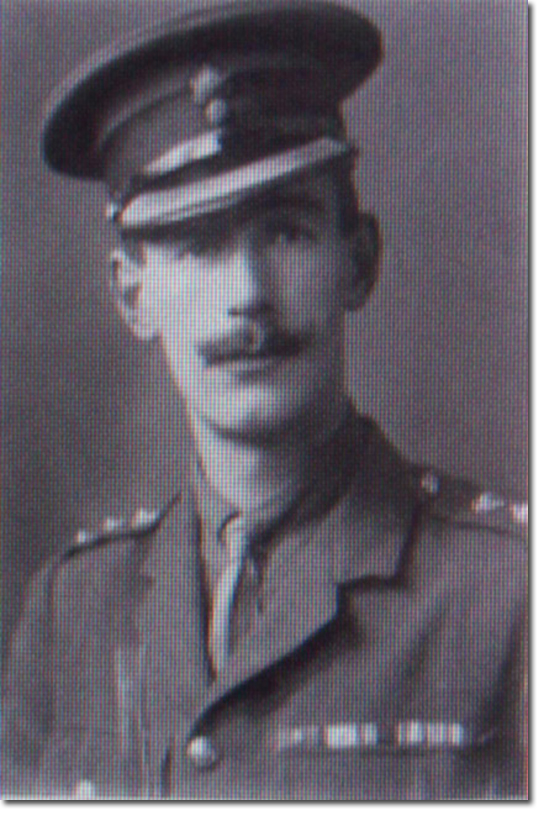|
|

 |
|
Wilfred Russell Bailey, 3rd Baron Glanusk of Glanusk Park was born on 27 June 1891. He was the son of Joseph Henry Russell Bailey, 2nd Baron Glanusk and Editha Elma Sergison. He was educated at Eton and went to Sandhurst in 1910. On 4 Feb 1911 he held the rank of 2nd Lieutenant in the Grenadier Guards and was promoted to Lieutenant on 8 Nov 1912. In Oct 1914 he was a lieutenant in No.1 Company 2nd Battalion at the 1st Battle of Ypres and in November he was appointed adjutant. He was then promoted to Captain in Sep 1915 at which time the battalion was fighting at Loos. He was still adjutant during the battle of The Somme in 1916. In a bayonet attack on a German trench at the Somme on 15 Sep 1916 Captain Vernon-Harcourt and Captain Bailey led their men against the enemy who were throwing grenades. They led by at least 50 yards and shot many of the enemy with their revolvers. About 60 of the enemy were accounted for mainly with the bayonet and 42 made prisoners: 'Captain Vernon-Harcourt himself, on arrival at the enemy's trench, was confronted by a stalwart German who immediately held up both hands and was made a prisoner, but Captain Bailey's man proved a fighter although happily a bad shot. Captain Bailey missed him with the first three shots of his automatic pistol but dispatched him with the fourth.'
He was awarded the DSO and promoted to temporary major on 10 Oct 1916 with the appointment of second in command of the 2nd Battalion. In Jan 1918 he had temporary command of the battalion for a month while Lt-Col Rasch was on leave. In July 1918 he transferred to the 1st Battalion to be second-in-command under Viscount Gort. He was temporarily commanding the 1st Battalion in August 1918 when he was wounded in the operations of 23 - 25 Aug. He recovered and arrived to take command of the 1st Battalion at the beginning of October 1918 and led further operations near Quievy from 11-14 Oct and at St Vaast from 20-22 Oct. His rank during Oct-Nov 1918 is quoted as Lieutenant-Colonel in the regimental history although it does not say that this is a temporary rank. He retired with the rank of major on 17 Feb 1924. He succeeded to the tile of Lord Glanusk on 11 Jan 1928. He was Lord-Lieutenant of Breconshire from 1928 until his death in 1948. In Sep 1939 he transferred from the Grenadier Guards to the Welsh Guards as commanding officer of the training battalion. He married, firstly, Victoria Mary Enid Ann Dugdale, daughter of Colonel Frank Dugdale and Eva Sarah Louise Greville, on 27 Feb 1919. But he and Victoria were divorced in 1939. He married, secondly, Margaret Eldrydd Shoubridge, daughter of Maj-Gen Thomas Herbert Shoubridge and Constance Gladys Dugdale, on 17 Mar 1942. They had a daughter, Elizabeth, born on 10 Sep 1943. He died of heart failure on 12 Jan 1848. The Times obituary was published on 13 Jan 1948: 'Lord Glanusk, Lord Lieutenant of Breconshire, died suddenly of heart failure yesterday at the age of 56 at his home near Crickhowell, Breconshire, one day more than 20 years after his father died in the act of opening the Brecon County War Memorial Hospital. Because he had a daughter and no son the family honours descend to his cousin, Lieutenant David Russell Bailey, R.N., son of the Hon. Herbert Crawshay Bailey, fourth son of the first Lord Glanusk. The Right Hon. Sir Wilfred Russell Bailey, D.S.O., third Baron Glanusk, of Glanusk Park, in the County of Brecon in the Peerage of the United Kingdom, and a baronet, was the eldest son of the second Baron Glanusk and was born on June 27, 1891. Educated at Eton and the Royal Military College, Sandhurst, he was commissioned in the Grenadier Guards and served throughout the 1914-18 was with his regiment. He was mentioned six times in dispatches, was twice wounded, and received the D.S.O. in 1916, to which a bar was added later. In 1918 he rose to the command of the first battalion of the Grenadier Guards, and retired from the Army in 1924 with the rank of major. He took a keen interest in the Boy Scout movement for many years and played a prominent part in local government in South Wales, having served on the Brecon County Council and as Chairman of the Brecon Standing Joint Committee. During the 1939-45 war he was re-employed and commanded for a time the training battalion of the Welsh Guards. He had been Lord Lieutenant of the county since 1928 and was appointed honorary colonel of the third battalion of The Monmouthshire Regiment in 1934 and of the Brecknock Battalion of The South Wales Borderers in 1939. In February 1942 he was appointed Commander of Auxiliary Units (taking over from Col. Major). He took up his post arriving in his Rolls Royce. Most of the officers were from the Guards Brigade and it did not take long before drill was added to the training schedule. He used his influence with GHQ Home forces to improve the SDS establishment. On 13 Oct 1943 Lt Col Lord Glanusk ceased to belong to the Reserve of Officers due to ill health. He was given the Honorary rank of Colonel.' |
Regimental details | Commanding Officers
Armed Forces | Art and Culture | Articles | Biographies | Colonies | Discussion | Glossary | Home | Library | Links | Map Room | Sources and Media | Science and Technology | Search | Student Zone | Timelines | TV & Film | Wargames